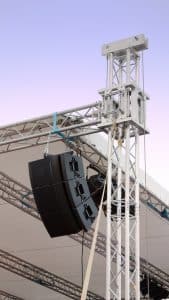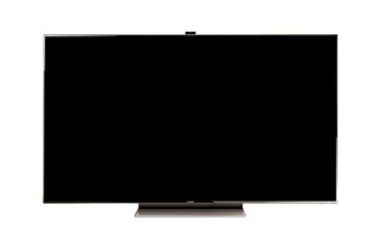Understanding Line Arrays
Have you ever been to a large event or festival in the recent past? If so, you’ve likely heard of line arrays of loudspeakers. Right now, they’re a must-have when it comes to big-time PA systems, but how did they transform to what they are today?
The key function of a PA system is to deliver big sound clearly to the audience. But perfecting the sound isn’t exactly as easy as it might sound. Other important factors are involved in delivering perfect sound to the audience, including:
▪ Adequate level according to the type of sound presented
▪ Low distortion and noise levels
▪ Flat frequency response
▪ Adequate clarity according to the type of sound presented
While getting an adequate level has never been an issue, achieving low distortion and noise, as well as a flat frequency response isn’t as problem-free. If the noise level of the PA is audible to the audience, there’s likely a flaw within the system itself. However, the frequency response of PA loudspeakers can be a real issue. Yet despite not being perfect, most people usually find the sound quality of an adequate PA system acceptable. In fact, this sound is basically expected from the average PA system.
Clarity is also another issue that has yet to be resolved. Of course, the PA system needs to be loud enough for all audience members to hear, which can be a challenge in and of itself.
Two scenarios present themselves: a seated audience, and a standing audience that is free to move about. If the audience is moving around, it’s perfectly fine to have various levels in various sections of the venue. Each audience member is free to move closer to the loudspeakers if they want louder sound, or move to quieter areas if that’s what they so desire.
A seated audience, on the other hand, presents more of a conundrum. There’s the issue of potentially blasting loud sound at the audience members at the front, while those in the back can barely hear. The task at hand is to ensure that all members of the seated audience – no matter where they happen to be in the venue – should be able to hear the sound loudly and clearly enough.

Multipurpose Acoustical Modeling Program (MAPP Online)
MAPP Online was developed by manufacturer Meyer Sound to mimic the sound fields created by its products in a number of configurations. Sound designers can enter data into the program, then obtain a graphical display of the coverage after clicking the ‘predict’ button.
This program allows users to do a number of things, including:
▪ Planning a loudspeaker system
▪ Determining delay settings for fill loudspeakers
▪ Observing interactions among loudspeakers
▪ Placing microphones at any point in the sound field
▪ Predicting the frequency and impulse response at microphone position
▪ Refining system design for optimal coverage of the audience area
▪ Pre–determining the right settings for optimal system response
▪ Obtaining load information regarding the array
MAPP Online is a fabulous tool for sound designers, and can run on Windows, Apple, and Unix computers. Data that is entered is sent to Meyer Sound’s servers where analysis and predictions are made and then delivered back to your computer.
The Theory of Directivity
There exists two extremes of directionality. One extreme is the point source where the source of the sound has no size. If a sound source is dimensionally smaller compared to the wavelength of sound that is being emitted, it has the traits of a point source.
A point source sends out sound waves equally in every direction. Picture this small point source emitting outwards for a brief moment: a sphere of high pressure will leave its surface and will radiate outward as it gets bigger and bigger. A certain amount of energy is present in this point source, and this energy will need to cover an increasingly larger area. For a point source, sound pressure declines by 6 decibels for each doubling of distance.
But not all sound obeys this theory; only sound from a point source will. All other sound sources that aren’t omnidirectional won’t obey this theory. The only way that sound can decline at a faster rate than 6 decibels for each doubling of distance is if something blocks it.
It’s interesting to consider the fact that it is possible to have a sound source at a level from which it doesn’t decline with increasing distance. It’s possible for a focused sound to cover a lot of distance without much decline in level.
The Line Source
Understanding the line source can be done by referring back to the point source. The point source must be small compared to the wavelength of sound that it’s emitting. The opposite is also true. Therefore, a very big sound source would be tightly directional, which is desirable. You essentially want a source that is able to be focused and directed to cover all audience members and not wasted on other parts of the venue.
However, think about a loudspeaker directed at an audience from a stage. The people right in front are spread from left to right, but from top to bottom, the spread is narrow. If the loudspeaker that focused the tight sound enough to direct sound adequately in the vertical dimension, full width of the audience would not be covered. The opposite is also true, which is not a good thing.
To solve this problem, a loudspeaker that’s tightly focused in the vertical dimension is needed. It also needs to spread sound widely within the horizontal dimension.
Waveguide
Earlier it was mentioned that individual sound sources need to be no further than half a wavelength apart in a line source. Another way to say this would be that the closer the individual sound sources are together, the higher up the maintenance of frequency spectrum line–source behavior will be. That means every cabinet needs to be as short as possible within the vertical dimension.
Ideally, the cabinet’s height shouldn’t be any more than the low-frequency drive unit’s diameter, in addition to the cabinet walls’ thickness. But to obtain a high sound level, the low–frequency drive units will need to be pretty big.
At 580Hz, signals are crossed over from low–frequency drive units to high–frequency drivers. In order for the concept of the line array to be appropriate, every cabinet must be a line source on its own. In order for this to happen, the high–frequency drive unit must have an innovative design to generate the necessary wavefront that hardly deviates at all within the vertical dimension. There are a few methods for this to happen.
One way is the ribbon drive unit, which has a long and thin diaphragm as high up as 15cm. The ribbon driver displays decent line-source behavior over approximately 4.5kHz; however, under that point, adjacent units will be over half a wavelength apart and won’t couple properly. In order for adequate coupling at higher frequencies to occur, the high–frequency driver needs to radiate over a minimum of 80% of the cabinet’s height. Ribbon drivers are pretty low on output in comparison to more traditional compression drive units.
Intensity and Divergence Shading
The purpose of a line array is to deliver sound to everyone in the audience at around the same level from the front to the back. It’s able to do this by focusing the sound vertically and letting it spread out horizontally. While line arrays can do this rather successfully, many times the front of the audience will get a higher sound–pressure level compared to the back. In order to alleviate this issue, the output of the line array’s lower section should be reduced, known as ‘intensity shading’.
The front audience rows are a lot nearer to the lower cabinets compared to the array’s upper cabinets. That way, the level from the lower cabinets will be reduced and will deliver a lower level of sound–pressure to the front of the audience. However, the front rows will still be hearing sounds coming from the array’s upper cabinets, and will hear it clearly because the cabinets are louder.
Yet sound from the higher cabinets will be delayed in relation to the lower cabinets. This will lead to an interference pattern, which can be dealt with through equalization and delay however, this would compromise the line array’s sophisticated concept.
An alternative to intensity shading is possible. When line arrays are flown, you’ll notice that front rows of the audience are just about under them. Instead, the back rows are a lot more on the same level as the top of the line array. Curving the lower section of the line array in order to make it point down at the front row of the audience is helpful, which creates a ’J’ shape.
This also helps with implemented divergence shading. Angling the cabinets apart requires that the sound produced to cover a wider angle and the intensity to be decreased at the listening position. This necessitates a more divergent cabinet for the curve of the J, which is dealt with through certain long–throw and front–fill cabinets.

